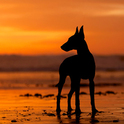ICB HIP DYSPLASIA PROJECT
Puppies Standing and Walking
Dog breeders and veterinary textbooks report that puppies begin to walk 2-4 weeks after birth. However, I have found that when newborn puppies are on a surface that provides adequate traction, they can stand at birth and most are able to walk.
These are videos of puppies (0 to 2 days old) of various breeds that I have tested on the Traction Mat. Puppies that are able to stand and walk from birth should be at lower risk of a number of disorders, including swimmer puppy, flat chest, and hip dysplasia.
You can learn more about the program developing the Traction Mat in the Facebook group for the ICB Hip Dysplasia Project. Videos of additional breeds will be posted here as they become available.
These are videos of puppies (0 to 2 days old) of various breeds that I have tested on the Traction Mat. Puppies that are able to stand and walk from birth should be at lower risk of a number of disorders, including swimmer puppy, flat chest, and hip dysplasia.
You can learn more about the program developing the Traction Mat in the Facebook group for the ICB Hip Dysplasia Project. Videos of additional breeds will be posted here as they become available.
Cocker Spaniel (American)
Golden Retriever
|
|
|
Labrador Retriever
Lagotto Romagnolo
|
|
|

